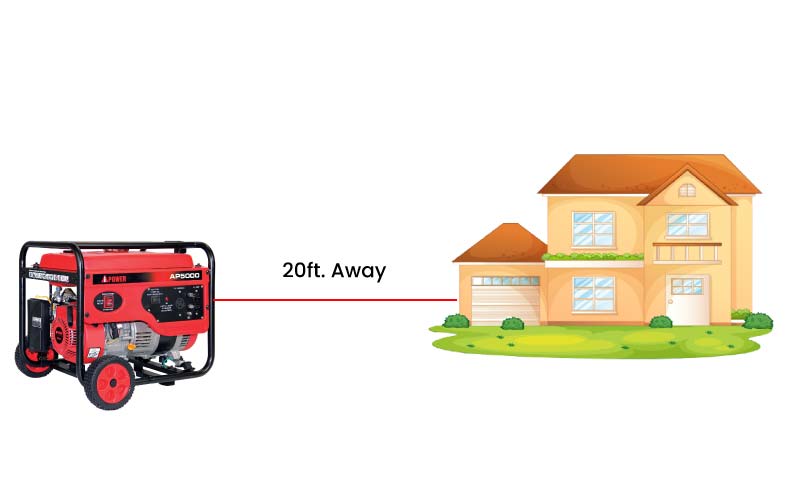How To Start A Generator? – Tips To Run Your Generator Smoothly
Generators are mostly used in areas where blackouts or power outage occurs frequently. Sometimes, people start panicking when they think to start a generator as they consider it a very hectic task. But knowing how to start a generator in an emergency situation can prove very helpful to deal with that particular situation.
In this article, we have explained in detail about each and every step involved in starting a generator. This step-by-step guide will help you to know how to start a generator and other important things that are required to keep in mind.
Preparation
Read The Owner’s Manual:
Everyone hates to read the manual guides provided by the owner. But all products are different and have unique quirks or operating procedures. So, checking out the manual to ensure you are assembling the generator correctly and having knowledge about how to start it properly is significant.
Arrange Required Supplies:
It is a great idea to keep all the necessary supplies with you before rushing to break in your generator. The most essential things that you may need are:
One of the best gas fuels is high-octane gasoline. While the oil plays its part in the longevity of the engine. So, it is important to use the oil recommended by the manufacturer to be used for the engine.
Oil conditioner helps a new engine to start in a smooth way. Wearing and tearing of the engine occur due to the dry start. So, professionals suggest using an oil conditioner along with oil. This combination of oil and oil conditioners will also assist your generator to remain safe when it isn’t in use for a long time.
Oil will stick to the walls by conditioner, preventing it from harsh or severe weather conditions.
Check If There Is Any Damage Or Gas Leak:
If a storm has struck your building, it’ll be good to check for the damage. Essentially, you may not want to use a gasoline-fueled generator if you have ever experienced a natural gas leak.
Here is the guide to test your generator
Place Generator Far From Home:

Well, it completely depends on you where you want to place your generator. But it is strongly recommended to run your generator at least 15 feet away from your home.
Never operate your generator inside a home, shed, or garage. As a generator produces different gases and all of them can be poisonous for you. If you run your generator inside the home, you could be killed within minutes due to carbon monoxide poisoning.
Checkout how to make generator quiter
Do Not Operate Generator (Unprotected) In A Storm:
On stormy days or nights, heavy rainfall can cause electrical shock while damaging the engine. But if there is an urgent need to operate the generator when it is raining then preferably buy a generator tent to protect your unit from any damage.
Checkout how to winterize your generator
Check Fuel Levels i.e., Oil And Gas:
To fuel a portable generator, you can use gas. But always make sure to fill up the generator with fresh reserves of gasoline. Ethanol present in gas will start absorbing water over time. If there is stale gasoline it will make it harder or impossible to start the engine and also cause huge damage to the engine.
It is also advised to check the level of oil in your generator to ensure the engine is getting proper lubrication. Fill the oil up to the line mentioned in the generator.
Checkout how to oil your generator
Remove Cords Plugged In, If There Is Any:
Disconnect all the cords before starting the generator. You should always start your generator before connecting it home. You may not want any load attached during the startup process.
Checkout our guide about Components Of A Generator
Turning On Your Generator
Turn On The Fuel Valve:
Now turn on the fuel valve. After releasing the fuel valve, fuel will travel to the carburetor to help in starting the generator.
Turn On Choke:
Then start moving the choke rod from right to left. This will make it easier for the engine to start running.
Turn Engine Switch-On:
Most generators require flipping the switch to turn on the engine. This is specifically an engine switch that flips on before pulling the recoil cord.
If the generator has an electric start button, you can use it to start the generator instead of using the recoil cord option. If somehow, the electric starter does not work, your battery may be dead. To resolve this issue, you can charge the battery on a trickle charger.
Pull Recoil Cord:
When you are pulling the recoil cord, you are actually trying to start the engine. Keep pulling the recoil cord until you feel resistance and then let it go back. If the engine of the generator doesn’t start after doing so, try to pull the cord once again.
Note: If the engine is not starting, then move the choke to half-run and pull the recoil cord again.
Operate Generator At No Load For Awhile
You will need to do this step if you are starting your generator for the first time in the whole day. The time length can vary from 1 minute to 5 minutes. It will make sure that your generator is in the right state to carry the load.
For subsequent starts, you can skip this step. It is suggested that never start the generator when the load is connected to it. Operate for at least 10 seconds when there is no load.
How To Hook Up Generator To House
Let your generator run for a few minutes before you start plugging in any cords.
Turn on the circuit breaker.
After running it for 3 to 5 minutes, you can now connect it to the house. A few steps to restore power are mentioned below:
Extension Cords:
The need for a proper gauge is undeniable when you are using an extension cord. For light-duty appliances, higher gauge extension cords will be required. While for heavy-duty appliances, a lower number gauge extension cord will be intended.
If something like Christmas lamps or lights are getting power, then a light-duty 16-gauge extension cord will be more than enough. But these types of cords are a fire hazard for most appliances you will plug into the generator.
A heavy-duty, 12-gauge extension cord or an extra heavy-duty 10-gauge extension cord will be needed. For example, a 10-gauge extension cord will be sufficient to power up your refrigerator.
Convenience Cords:
Another important or simple option you can rely on is a convenience cord that allows you to plug in multiple items at a time. Instead of binding individual appliances to the generator, you can plug it in this cord and then extend it out to wherever most of your appliances are residing. In the end, plug in multiple appliances from there.
Through-the-wall kit:
With the help of a through-the-wall kit for your generator, you can easily give power to indoor appliances without having to run cords outside.
For this purpose, just a simple drill through the wall in order to connect an indoor power panel with an outdoor power inlet box. Furthermore, connect a generator to the outdoor power inlet box with the help of a power cord.
In the end, you can easily plug your indoor appliances inside the indoor power panel and then the generator will give power to them.
Power Cord & Transfer Switch:
You can also use a manual transfer switch with the power cord of the generator. The initial setup takes a bit more time for this option and the upfront cost may be higher than this. But no doubt, it makes the operating system of your generator faster and easier.
A transfer switch allows you to power critical loads to the circuit panel of your home without powering individual appliances that use extension cords. It means you can run hard-wired household appliances such as ceiling fans, from the generator power. This will be a convenient and long-term solution to the power cord of the generator.
Checkout our guide about how much a generator cost?
Refueling:
Unplug all the cords from the generator when you are going to refuel it. And let your generator run for a few minutes to get sable. Then, turn it off and let it cool before adding more fuel inside it. You can repeat this process to turn your generator back on.
Reasons Your Generator Won’t Start
After applying all of these steps, if your generator is still not starting, then don’t worry. Follow these below-mentioned instructions to find out the problems associated with the generator:
Low On Oil:
Check the level of oil in the crankcase and add oil if it is low. One thing you should keep in mind is that when you try to attempt to run the generator on an uneven surface, it may cause a low oil sensor to trigger despite being enough oil.
Out Of Gas:
Check the gas tank to find out if there is a sufficient amount of gasoline present inside the tank. If there is a need to add fresh gasoline then add it to avoid clogging that may result due to using old or stale gasoline. Replace the gasoline even if it is two months older.
The Choke Lever Is Misplaced:
The choke of an engine should be set to ‘close’ during startup and moved to ‘open’ when the engine gets warm. This choke lever may be located in a few different locations depending on the design of your generator. It can be found just above the air filter on the side of many generators. The choke is integrated into the power control knob on others.
When starting the generator, it should be set to close (also known as the start or choke position) in any case. Move the choke to the ON/RUN/OPEN position for functioning once the engine has started. The choke lever should be put to the RUN (open) position for starting if the engine is already warm
The Fuel Valve Is Clogged:
If the gas tank is full but no fuel is reaching the carburetor then there must be a problem with the fuel line or fuel valve. A fuel valve is responsible for controlling the flow of fuel from the gas tank to the carburetor. Ensure that it is set to open allowing fuel to flow into proper channels.
If the valve is set to open already but the fuel is still not properly flowing then you can try the following two things.
- If there is a vacuum relief valve at the top of a gas tank, then it must be opened.
- Unplug the outlet hose from the intake side of the fuel valve to find out if gasoline is flowing freely or not.
This will determine what part of the fuel line is clogged up. If an in-line fuel filter is present between the carburetor and fuel valve, check it out to make sure it is unblocked.
Spark Plug Needs Replacement:
With the passage of time, deposits and buildup can develop on the spark plug. Check it out with the help of a spark plug wrench. Clean the spark plug by using a small knife or a similar tool. Also, ensure that the electrode is properly gapped.
Pull the recoil starter to test the plug while holding the body of the spark plug to the engine crankcase. If the spark is strong with blue color, then the ignition coil is better. If there is no spark or there is a weak spark, it is good to remove the spark plug and cap.
To check the ignition coil, place the end of the spark plug wire near the engine’s body and pull the recoil starter. If sparks are now visible between the spark plug boot and the engine, the spark plug should be replaced. The ignition coil may need to be replaced if there are no sparks.
Other:
There are many other reasons for a generator not starting properly, such as the carburetor being clogged or air locked, the battery is dead, the oil sensor is not working properly or the air filter needing cleaning. By resolving all these issues, you can easily start a generator.
Tips To Run The Generator Smoothly

Josh is a highly skilled electrician with specialized expertise in the field of generators. With years of experience under his belt, he has established himself as an expert in all aspects of generators, ranging from installation and maintenance to troubleshooting and repairs. Josh’s in-depth knowledge of electrical systems and his commitment to staying updated with the latest industry advancements make him a reliable and sought-after professional.
